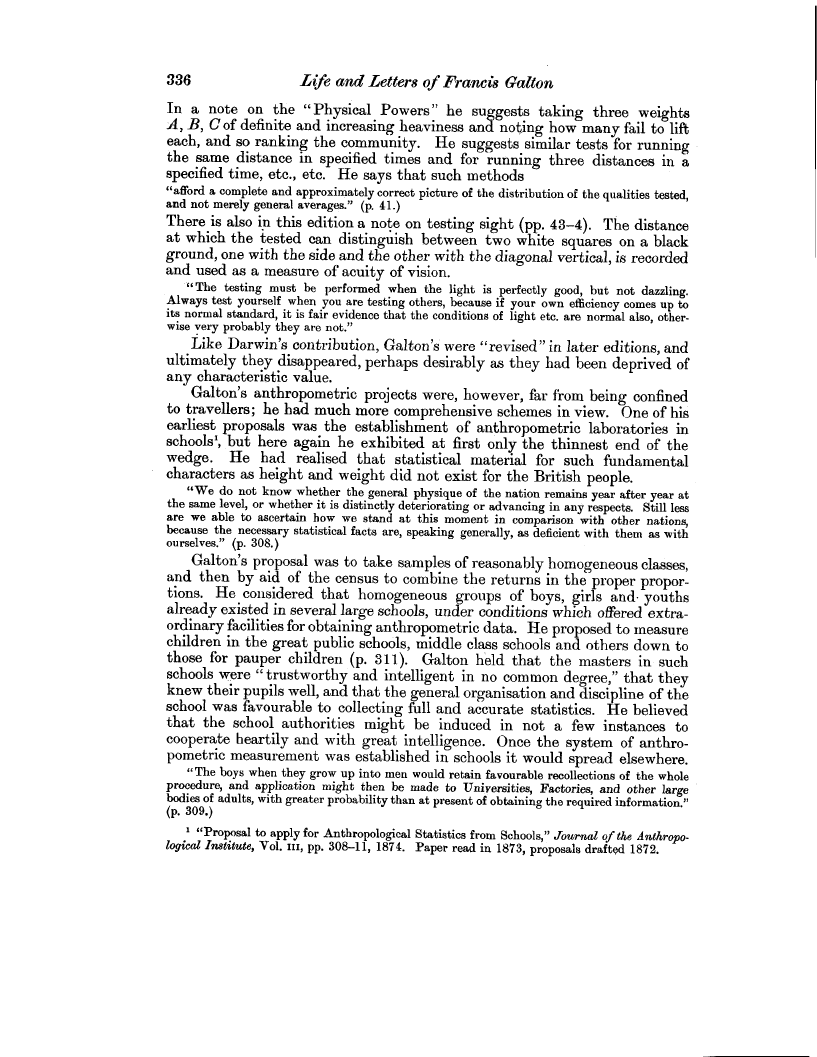336 Life and Letters of Francis Galton
In a note on the "Physical Powers" he suggests taking three weights A, B, C of definite and increasing heaviness and noting how many fail to lift each, and so ranking the community. He suggests similar tests for running the same distance in specified times and for running three distances in a specified time, etc., etc. He says that such methods
"afford a complete and approximately correct picture of the distribution of the qualities tested, and not merely general averages." (p. 41.)
There is also in this edition a note on testing sight (pp. 43-4). The distance at which the tested can distinguish between two white squares on a black ground, one with the side and the other with the diagonal vertical, is recorded and used as a measure of acuity of vision.
"The testing must be performed when the light is perfectly good, but not dazzling. Always test yourself when you are testing others, because if your own efficiency comes up to its normal standard, it is fair evidence that the conditions of light etc. are normal also, other
wise very probably they are not."
Like Darwin's contribution, Galton's were "revised" in later editions, and ultimately they disappeared, perhaps desirably as they had been deprived of any characteristic value.
Galton's anthropometric projects were, however, far from being confined to travellers; he had much more comprehensive schemes in view. One of his earliest proposals was the establishment of anthropometric laboratories in schools', but here again he exhibited at first only the thinnest end of the wedge. He had realised that statistical material for such fundamental characters as height and weight did not exist for the British people.
"We do not know whether the general physique of the nation remains year after year at the same level, or whether it is distinctly deteriorating or advancing in any respects. Still less are we able to ascertain how we stand at this moment in comparison with other nations, because the necessary statistical facts are, speaking generally, as deficient with them as with
ourselves." (p. 308.)
Galton's proposal was to take samples of reasonably homogeneous classes, and then by aid of the census to combine the returns in the proper proportions. He considered that homogeneous groups of boys, girls and- youths already existed in several large schools, under conditions which offered extraordinary facilities for obtaining anthropometric data. He proposed to measure children in the great public schools, middle class schools and others down to those for pauper children (p. 311). Galton held that the masters in such schools were "trustworthy and intelligent in no common degree," that they knew their pupils well, and that the general organisation and discipline of the school was favourable to collecting full and accurate statistics. He believed that the school authorities might be induced in not a few instances to cooperate heartily and with great intelligence. Once the system of anthropometric measurement was established in schools it would spread elsewhere.
"The boys when they grow up into men would retain favourable recollections of the whole procedure, and application might then be made to Universities, Factories, and other large bodies of adults, with greater probability than at present of obtaining the required information."
(p. 309.)
1 "Proposal to apply for Anthropological Statistics from Schools," Journal of the Anthropological Institute, Vol. III, pp. 308-11, 1874. Paper read in 1873, proposals drafted 1872.

